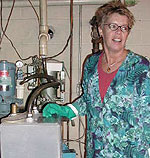By Stephanie Hemphill
Minnesota Public Radio
October 2, 2002
If you were asked to name a source of mercury pollution in your community, what would it be? It turns out dental offices are the largest source of mercury in most cities' sewage systems. Mercury is known to damage the nervous system and impair childrens' mental development. Now, dentists in Duluth are leading the way in reducing the amount of mercury going into the environment.
| |
|
|
|
||
Mercury is an essential part of dental amalgam. The mercury keeps the material soft until it's pressed into the cavity, then it bonds to form a very durable filling. The problem is the small bits of amalgam that don't make it into the filling. The suction hose that cleans them out of your mouth generally dumps them down the drain. So they can easily end up in a lake or river, where they can be eaten by fish.
The average dental office creates about a half pound of waste mercury every year. Just a tablespoonful of mercury will pollute a lake enough to warrant fish advisories.
According to Tim Tuominen, dental offices are the biggest contributors to mercury in the sewer system.
Tuominen is a pollution prevention specialist with the Western Lake Superior Sanitary District. He's been working with dentists in Duluth for nearly ten years to reduce the mercury they wash down the drain.
He started with the vacuum systems nearly all dentists already have. When the suction hose whisks amalgam out of your mouth, the pieces are held in a filter to keep them from damaging the pump. Tuominen showed the dentists how to safely recycle the captured amalgam.
Since then, monitoring equipment shows the amount of mercury coming into Duluth's wastewater treatment plant has been cut in half every two years.
To cut down on mercury even more, Tuominen got a grant to buy more expensive equipment that captures up to 99% of the amalgam. He offered the equipment free to any dentist who would agree to use it.
Tuominen installs the systems and trains office staff in their operation. "That only takes about half an hour," he says. "Then after six months I show them how to manage the solids particles that collect over that time period. So it's really pretty simple."
| |
|
|
|
||
Most of the dental offices in Duluth have installed the systems, and Tuominen expects the rest to follow suit.
Lorraine Kellerman operates the system in one dental office.
Once a week she empties the chair-side traps and puts the chunks of amalgam into a container for recycling.
Then she goes down to the basement where a tank, like an aquarium, collects the finer particles. The heavy amalgam settles to the bottom of the tank, and Kellerman decants the water off every week.
That process is simple too, Kellerman says. "We just put the hose in the drain, turn the lever, and just wait 'til the fluid runs out. It only takes a few minutes."
Once a year the amalgam that collects at the bottom is cleaned out and recycled.
| |
|
|
|
||
"The beauty of this technology is in its simplicity," according to Kellerman's boss, Jim Westman. "Gravity works, it's simple, it's very inexpensive."
Westman says the dentists in Duluth are happy to use the equipment. It costs about $500, and the recycling charge is about $50 a year.
Westman is chair of the Minnesota Dental Association's environmental committee. Members been working on a plan to help dentists around the state reduce their output of mercury. Westman says they want to make it easy for dentists. They'll be able to answer dentists' questions about equipment options and how to recycle the mercury.
"Who are my resources to call on handling, transport, process? It's that 'who you going to call' side of the question that's going to make a difference as we build a bigger program," Westman says.
The city of Seattle, and some states in New England, have passed legislation requiring dentists to reduce the amalgam going into the wastewater. Westman says the voluntary approach pioneered in Duluth can work better than regulations.



